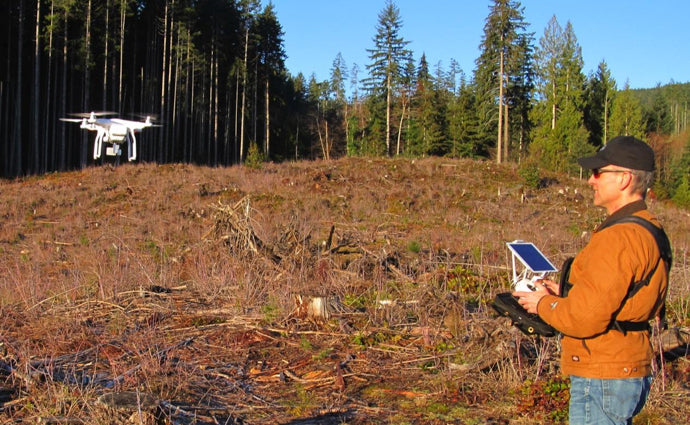As a Forester on Canada’s west coast, I have had the opportunity to work in some pretty spectacular places. Often the work environment is very challenging: rugged terrain, terrible brush, along with weather that can sometimes be pretty nasty. These conditions make the reliable operation of a UAV challenging. Despite this, I have found the DJI Phantom 4Pro to be a great tool to have in the toolbox.
In most cases, I have used the Phantom 4 to assess the health and vigour of young forests. The live video feed and still photos captured by the UAV are an absolute game changer for these assessments. I get much better information than I can get by conventional means – and I am much more efficient! I still find that I have to walk into many areas, as there are some things that cannot be seen in the UAV imagery. However, these walks in the woods are much more targeted, as I have a better idea of where to go.
Although the live video feed is valuable, there is some time pressure because the flight times are limited to about 20-25 minutes. I have found that capturing photos for review when the UAV is on the ground allows me to examine areas of interest much more thoroughly. Normally, I will transfer the photos stored on the UAV micro SD card onto my iPad.
This makes the SD card adapter my most prized UAV accessory!

Once the photos are on the iPad, I will often import them into Avenza Maps, where they appear as waypoints. I can then see where the photo was captured on top of a map. If I see something in the image that warrants a closer look, I can walk to within a couple of meters of the location. This is by far the most valuable workflow I have found for assessments of young forests! If this were all I could do with the imagery, it would be well worth the investment in the hardware and training!
I have also flown mapping missions to create 2D and 3D models. These can be very valuable ways to share information regarding the area of interest. However, it is not something I can create while I am in the field in a timely manner. Making imagery available quickly, to facilitate decisions while on site, is tremendously valuable!
I have had the Phantom 4Pro for a little over a year now. Although it is surprisingly easy to operate, I have found a few things that can be an issue if you are caught unprepared:
- Sudden increase in the wind speed. If you are downwind with a low battery you could end up having to perform an emergency landing: Practice emergency landings.
- Failure of the Tablet. I overheated my iPad on a hot summer day. This interrupted a flight until the iPad could be restarted.
- Flying until the battery is “Critically Low”. I did this intentionally to see what would happen. The UAV will land automatically, but you have little control over where it lands.
- UAV not level during takeoff. I was launching from a moderately steep road and flipped the Phantom on its back. I had to replace a couple of the propellers.
- Landing in a very tight spot. Essentially, I was landing in a location where there were trees on all sides of a 3-meter diameter cylinder. The obstacle avoidance system kicked in and prevented the UAV from moving horizontally in “Positioning” mode. By switching to “Attitude” mode, I could move horizontally, but it was very difficult to control the UAV in such a tight space: Avoid tight spots unless you are a much more skillful pilot than I am!
- Loss of signal. If you have set the return-to-home height and location appropriately, this is not a significant issue.
- Maintaining visual line of sight with the UAV can be very challenging in forested environments. Finding a location where you can launch and retrieve the UAV, plus see it throughout the mission, can require venturing off of the road. This has caused me to hand launch and retrieve the UAV on occasion.
- Hand Launch and Retrieval. If you Google “Drone Rotor Injuries”, you will see some graphic injuries that are the result of being struck by a drone. Don’t consider hand launching and retrieval without appropriate personal protective equipment. In addition to protecting your face, I would recommend gloves and a heavy jacket.

In the photo above, you can see that I am using one of our Ruxton Packs as a support for the UAV controller and tablet. The controller is secured on the pack with a custom bracket. I have found that it is much more comfortable and secure than holding it in my hand. We would really like to know if there are other UAV pilots that would like this option.
Brian Saunders

